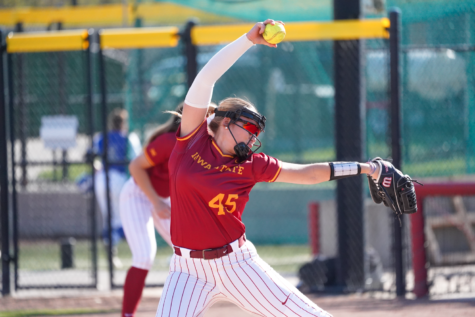TRACK AND FIELD:Mental preparation is key for sprinters
April 20, 2009
Editor’s note: Editor’s note: This is the second of a four-part series discussing a typical workout for the four different groups of the ISU track-and-field teams. Today will highlight the sprinters, with subsequent articles discussing jumpers and distance runners. Check online for Monday’s story about the throwers.
At 3:30 on a sunny afternoon, a group filled a small bleacher section in the corner of the track at Lied Recreation Center. Their attention was focused on the clean-shaven, well-dressed man in front of them. He addressed the athletes as a teacher would a room full of students, and just like any other Wednesday, he taught them everything they would need to know for the weekend.
“I want everybody to get out and get in a final,” assistant coach Nate Wiens told his group of sprinters. “We got everybody into their races, so go out and show Kansas what we’ve got.”
The sprinters of the ISU track-and-field team were preparing to travel to Lawrence, Kan., for the Kansas Relays, and Wiens wanted them to be ready for their long weekend.
He and volunteer assistant Danny Harris went over rules and plans for the weekend — from when they would be departing for the weekend to a reminder for the relay teams to wear matching uniforms. It all seems very simple, but for the coaches it is very important.
“It’s about mental preparedness,” Wiens said. “The last thing we want is an athlete going out there not sure when they’re supposed to check in. Then they’re just a nervous wreck and they’re not focused on the race.”
As Wiens continued to read from his meet packet, he told the team about the variety of awards to be given to event winners and place finishers. Unlike other meets, watches were to be given out to the winners in each event, although medals would still be given to second and third-place finishers.
“Go out there and get some watches,” Wiens said. “Let’s take everything we can out of that place.”
Wiens also told his athletes he wanted to see them start their “flow of progression.” He emphasized taking jumps each week into the Big 12 Championships and beyond.
That mental preparedness and focus is something Wiens believes to be key to his athletes making those big jumps at each competition.
“We’re just trying to instill in them that confidence to say ‘whatever I did last weekend I’m going to top this weekend, and whatever I do this weekend I’m going to top next weekend,’” Wiens said.
Wiens flipped through the final pages of the packet, and then flipped through again to make sure he did not miss a note. With just 20 minutes gone, the meeting was over and he tossed the packet away.
During the workout that followed, the group did primarily range-of-motion exercises along with several stretches and warm-ups involved in their pre-meet routine.
Each Wednesday, the sprinters get a light day of work to allow for recovery and rest from the grind that is their weekly workload.
“It definitely is nice, especially when at the beginning of the week you come in and get after it,” said junior Jenna Caffrey. “Then it’s kind of a time to let your system relax.”
Caffrey was also nursing a sore leg during the workout, so a light workout provided another chance for her body to heal and get back to full strength.
“It just gets me in to it a little more, kind of taking that next step coming back into getting up to speed,” Caffrey said.
During the grueling outdoor season, it falls to the coaching staff to determine the weekly workload for each athlete, and Wiens said its “absolutely fundamental” for him to balance work and rest through each training cycle. It is still up to the individual athlete to make the ends meet by working hard as well as sleeping and eating properly.
Wiens said resting days are important not only to let the body recover, but for mental recovery as well.
















